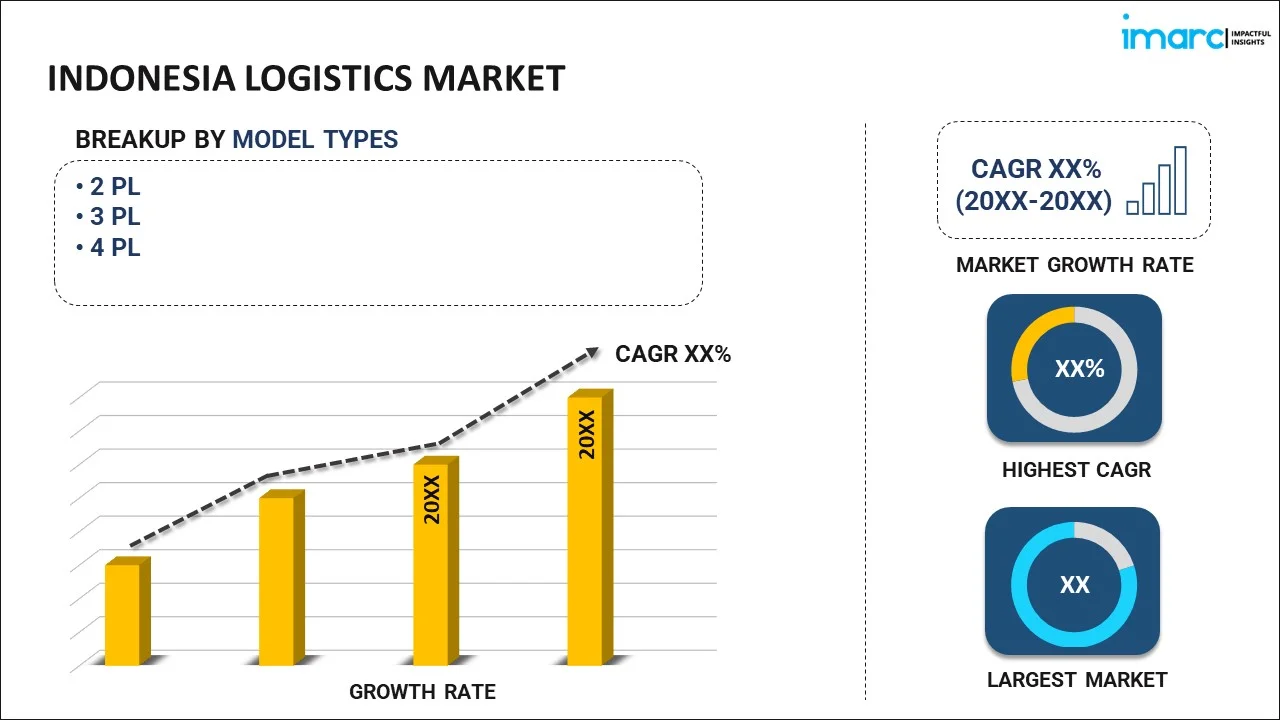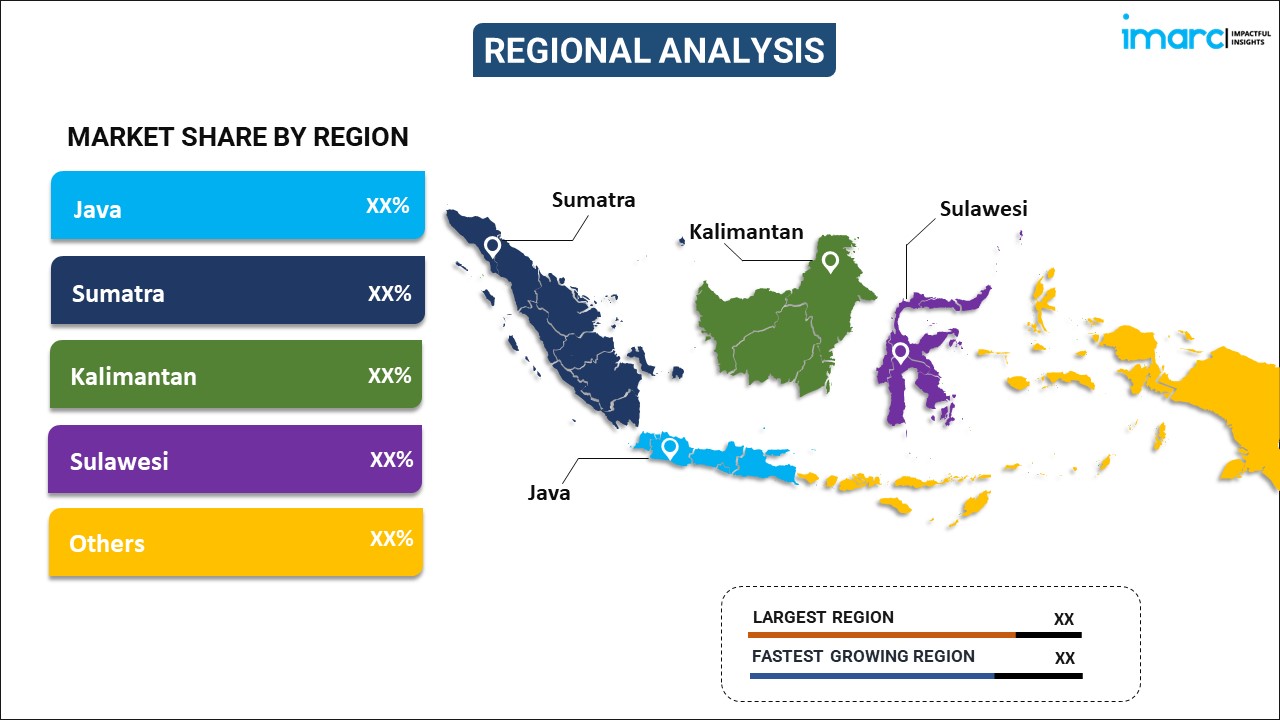
Indonesia Logistics Market Report by Model Type (2 PL, 3 PL, 4 PL), Transportation Mode (Roadways, Seaways, Railways, Airways), End Use (Manufacturing, Consumer Goods, Retail, Food and Beverages, IT Hardware, Healthcare, Chemicals, Construction, Automotive, Telecom, Oil and Gas, and Others), and Region 2024-2032
Indonesia Logistics Market Size:
Indonesia logistics market size reached US$ 105.29 Billion in 2023. Looking forward, IMARC Group expects the market to reach US$ 205.26 Billion by 2032, exhibiting a growth rate (CAGR) of 7.20% during 2024-2032. The market is majorly driven by the rapid rise in e-commerce activities, substantial infrastructure investments, regional trade liberalization, adoption of advanced technologies, and supportive government policies.
|
Report Attribute
|
Key Statistics
|
|---|---|
|
Base Year
|
2023 |
|
Forecast Years
|
2024-2032 |
|
Historical Years
|
2018-2023
|
| Market Size in 2023 | US$ 105.29 Billion |
| Market Forecast in 2032 | US$ 205.26 Billion |
| Market Growth Rate (2024-2032) | 7.20% |
Indonesia Logistics Market Analysis:
- Major Market Drivers: The major drivers of the Indonesia logistics market include the expanding e-commerce sector, extensive infrastructure development, trade liberalization, technological advancements, and supportive government initiatives, all contributing to enhanced market growth and increased efficiency.
- Key Market Trends: Key trends in the market involve the adoption of advanced technologies including IoT, blockchain, and AI, increasing investments in green logistics practices, and the formation of strategic partnerships and collaborations to strengthen supply chain networks and expand service offerings.
- Competitive Landscape: Some of the major market players in the Indonesia logistics industry include JNE, Pos Indonesia, Tiki, DHL, J&T Express, and SiCepat, among many others, actively enhancing operations, investing in technology, and expanding their regional and international presence.
- Challenges and Opportunities: Some of the market challenges include infrastructure gaps and regulatory complexities, while opportunities arise from the growing demand for efficient logistics solutions driven by e-commerce, regional trade agreements, and government policies promoting sector growth and sustainability practices.
Indonesia Logistics Market Trends:
E-commerce expansion
The rapid growth of e-commerce channels is influencing the Indonesia logistics market growth. The developments of the internet and the present-day facilities of smart phones have led to the increased use of online shopping thus calling for appropriate solutions of logistics to deal with the increased volume of parcel deliveries. Major companies are looking for efficient attainments such as warehouses, future distribution centers, and last-mile networks that fit the requirements. The incorporation of automation upon transportation, as well as tracking in real-time, is likewise helping increase the quality and usefulness of such services, which, in turn, is appealing to consumers and businesspersons alike. With e-commerce retailing on the rise, there is likelihood that the logistics market will equally grow in the future thus creating the chances of growth and development in Indonesia. According to a report, the COVID-19 pandemic has led to a rise in local e-commerce with reports suggesting that the internet economy is likely to account for as much as 50% of all commercial transactions by 2025.
Ongoing infrastructure development
The infrastructure factor is another critical element that has propelled the development of the Indonesia logistics market share significantly. Indonesia has been focusing heavily on connectivity to the various islands in the country mainly through the development of roads, seaports and airports. These adjustments promote efficient and effective movement of goods, that in turn cuts the transit time as well as costs. The improvement has not only benefited the local logistics demand to develop smoothly, but also greatly propelled Indonesia’s logistics export market. They have enhanced the flow of synchronization, which is useful for the growth of business and increasing market access and helping the logistics sector turn more competitive.
Government initiatives and policies
Indonesia logistics market outlook is highly dependent on positive governmental actions and politics. Indonesian government has been putting in various initiatives with the aim of developing the logistics industry. Solutions being implemented in this regard include the national logistics system which seeks to integrate a good and efficient logistics structure across the nation. They are also undertaking an expenditure on special economic zones (SEZs) and logistic parks for the improvement in the performance of logistics. Also, the implementation of policies to remove constraints such as excessive red tape to ease the business environment are leading to increased domestic and foreign investments in the logistics industry. Such governmental supports persist in encouraging the congenial climate of logistics firms and, therefore, improving Indonesia’s logistics market.
Indonesia Logistics Market Segmentation:
IMARC Group provides an analysis of the key trends in each segment of the market, along with forecasts at the country and regional levels for 2024-2032. Our report has categorized the market based on model type, transportation mode, and end use.
Breakup by Model Type:

- 2 PL
- 3 PL
- 4 PL
The report has provided a detailed breakup and analysis of the market based on the model type. This includes 2 PL, 3 PL, and 4 PL.
Breakup by Transportation Mode:
- Roadways
- Seaways
- Railways
- Airways
A detailed breakup and analysis of the market based on the transportation mode have also been provided in the report. This includes roadways, seaways, railways, and airways.
Breakup by End Use:
- Manufacturing
- Consumer Goods
- Retail
- Food and Beverages
- IT Hardware
- Healthcare
- Chemicals
- Construction
- Automotive
- Telecom
- Oil and Gas
- Others
The report has provided a detailed breakup and analysis of the market based on the end use. This includes manufacturing, consumer goods, retail, food and beverages, IT hardware, healthcare, chemicals, construction, automotive, telecom, oil and gas, and others.
Breakup by Region:

- Java
- Sumatra
- Kalimantan
- Sulawesi
- Others
The report has also provided a comprehensive analysis of all the major markets in the country, which include Java, Sumatra, Kalimantan, Sulawesi, and others.
Competitive Landscape:
- The market research report has also provided a comprehensive analysis of the competitive landscape in the market. Detailed profiles of all major companies have been provided.
- Businesses are integrating sophisticated technology in their supply chain, including automated warehousing systems, real-time tracking, and powerful data analysis. It signifies that new strategic alliances and collaborative are emerging to enhance supply chain relations as well as service portfolios. Further, these players are concentrating on implementing new storage facilities, distribution channels, and optimizing last-mile logistics due to the escalating online selling platforms. Companies that are seeking to grow their regional and international markets to build the sales front. They are enabling the key players to sustain competitive edge and indeed fuelling the general Indonesia logistics market.
Indonesia Logistics Market Report Scope:
| Report Features | Details |
|---|---|
| Base Year of the Analysis | 2023 |
| Historical Period | 2018-2023 |
| Forecast Period | 2024-2032 |
| Units | US$ Billion |
| Scope of the Report | Exploration of Historical Trends and Market Outlook, Industry Catalysts and Challenges, Segment-Wise Historical and Future Market Assessment:
|
| Model Types Covered | 2 PL, 3 PL, 4 PL |
| Transportation Modes Covered | Roadways, Seaways, Railways, Airways |
| End Uses Covered | Manufacturing, Consumer Goods, Retail, Food and Beverages, IT Hardware, Healthcare, Chemicals, Construction, Automotive, Telecom, Oil and Gas, Others |
| Regions Covered | Java, Sumatra, Kalimantan, Sulawesi, Others |
| Customization Scope | 10% Free Customization |
| Report Price and Purchase Option | Single User License: US$ 3699 Five User License: US$ 4699 Corporate License: US$ 5699 |
| Post-Sale Analyst Support | 10-12 Weeks |
| Delivery Format | PDF and Excel through Email (We can also provide the editable version of the report in PPT/Word format on special request) |
Key Questions Answered in This Report:
- How has the Indonesia logistics market performed so far, and how will it perform in the coming years?
- What has been the impact of COVID-19 on the Indonesia logistics market?
- What is the breakup of the Indonesia logistics market on the basis of model type?
- What is the breakup of the Indonesia logistics market on the basis of transportation mode?
- What is the breakup of the Indonesia logistics market on the basis of end use?
- What are the various stages in the value chain of the Indonesia logistics market?
- What are the key driving factors and challenges in the Indonesia logistics market?
- What is the structure of the Indonesia logistics market, and who are the key players?
- What is the degree of competition in the Indonesia logistics market?
Key Benefits for Stakeholders:
- IMARC’s industry report offers a comprehensive quantitative analysis of various market segments, historical and current market trends, market forecasts, and dynamics of the Indonesia logistics market from 2018-2032.
- The research report provides the latest information on the market drivers, challenges, and opportunities in the Indonesia logistics market.
- Porter's five forces analysis assists stakeholders in assessing the impact of new entrants, competitive rivalry, supplier power, buyer power, and the threat of substitution. It helps stakeholders to analyze the level of competition within the Indonesia logistics industry and its attractiveness.
- The competitive landscape allows stakeholders to understand their competitive environment and provides an insight into the current positions of key players in the market.
Need more help?
- Speak to our experienced analysts for insights on the current market scenarios.
- Include additional segments and countries to customize the report as per your requirement.
- Gain an unparalleled competitive advantage in your domain by understanding how to utilize the report and positively impacting your operations and revenue.
- For further assistance, please connect with our analysts.
 Inquire Before Buying
Inquire Before Buying
 Speak to an Analyst
Speak to an Analyst
 Request Brochure
Request Brochure
 Request Customization
Request Customization




.webp)




.webp)












